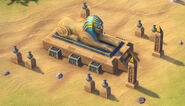No edit summary Tag: Visual edit |
(→Iteru) Tag: Visual edit |
||
| Line 23: | Line 23: | ||
=== '''Iteru''' === |
=== '''Iteru''' === |
||
| + | |||
| + | ==== ''Boosted Production to riverside construction of Districts and Wonders'' ==== |
||
| + | |||
| + | ==== ''Districts and Wonders can be built on Floodplains (Vanilla and Rise and Fall only)'' ==== |
||
| + | |||
| + | ==== ''Units and infrastructure immune to Flood damage (Gathering Storm only)'' ==== |
||
=== '''Mediterranean's Bride''' === |
=== '''Mediterranean's Bride''' === |
||
Revision as of 05:21, 9 July 2020
The Egyptian people represent a civilization in Civilization VI. Their colors are dark turquoise (#155760) and yellow (#FFFF58), and they are led by Cleopatra.
The Egyptians' civilization ability is Iteru, which decreases the build time of wonders and districts adjacent to rivers and grants them the ability to build wonders and districts on Floodplains. In Civilization VI: Gathering Storm, Egyptian units, improvements and districts are immune to flood damage. Their unique unit is the Maryannu Chariot Archer (which, before Gathering Storm, replaces the Heavy Chariot), and their unique tile improvement is the Sphinx.
Strategy
Egypt under Cleopatra is a wildcard, since they are skewed towards many Victory conditions that it is impossible to know what they are up to. Whether building up a Religious army of Missionaries and Apostles ready to convert the entire world, laying down multiple Theater Squares and Wonders for an inexorable Cultural Victory, sending ![]() Trade Route Trade Routes to improve their economy, or even investing in their powerful but extremely expensive unique unit to take our unsuspecting neighbors, Egypt can do it all. Egypt is a rare Cultural civilization that can also be on the offense, underestimating Egyptian militaristic prowess in the early game can spell doom to most empires.
Trade Route Trade Routes to improve their economy, or even investing in their powerful but extremely expensive unique unit to take our unsuspecting neighbors, Egypt can do it all. Egypt is a rare Cultural civilization that can also be on the offense, underestimating Egyptian militaristic prowess in the early game can spell doom to most empires.
Iteru
Boosted Production to riverside construction of Districts and Wonders
Districts and Wonders can be built on Floodplains (Vanilla and Rise and Fall only)
Units and infrastructure immune to Flood damage (Gathering Storm only)
Mediterranean's Bride
Maryannu Chariot Archer
The Maryannu Chariot Archer is a very powerful early game unit. On flat terrain, its ![]() Movement Movement is unmatched by any standard unit of its time and equaled only by the War-Cart and the Saka Horse Archer...neither of which can compete with the Maryannu Chariot Archer's
Movement Movement is unmatched by any standard unit of its time and equaled only by the War-Cart and the Saka Horse Archer...neither of which can compete with the Maryannu Chariot Archer's ![]() Range Range and high
Range Range and high ![]() Ranged Strength. Its drawbacks are its high
Ranged Strength. Its drawbacks are its high ![]() Production and maintenance costs, but a few of these units with Warrior backup can give the Egyptians an early military lead and allow them to cripple or eliminate unprepared neighbors.
Production and maintenance costs, but a few of these units with Warrior backup can give the Egyptians an early military lead and allow them to cripple or eliminate unprepared neighbors.
After Rise and Fall, the Maryannu Chariot Archer's classification as a ranged cavalry unit means it can benefit from both Agoge and Maneuver (and their respective upgraded cards), but the bonuses do not stack. In Gathering Storm, it becomes independent, so Egypt can build Heavy Chariots and does not have to rely on Warriors as the only frontline option to back up its Maryannu Chariot Archers. When playing as Egypt, it is recommended that you run Maneuver since it benefits both units you need, so you can quickly build a fast-moving, hard-hitting army to conquer your enemies early on. Due to its very high cost, it is the one unit that you either build only one to get 4 Era Scores and then ignore entirely, or build more than one but you have to go on a conquest to get something about of the investment. If your neighbors do not have early defensive mechanism, it is very simple to take them out completely with a few Maryannu Chariot Archers and Heavy Chariots or Horsemen.
Sphinx
The Sphinx has some of the least restrictive placement requirements of any improvement - any passable land tile is fair game, except for Snow and Snow Hills in Gathering Storm. The Egyptians should build them on tiles that cannot support other improvements, or adjacent to wonders for some extra ![]() Faith. Thanks to their Appeal bonus, well-placed Sphinxes can create good spots for Seaside Resorts and National Parks, or increase the yields of those that are already there.
Faith. Thanks to their Appeal bonus, well-placed Sphinxes can create good spots for Seaside Resorts and National Parks, or increase the yields of those that are already there.
Before Gathering Storm, the Sphinx grants +1 Appeal to adjacent tiles, but with Gathering Storm, it grants +2 Appeal, which is equivalent to a Natural Wonder other than Uluru or the Appeal amount granted by the Eiffel Tower, a Modern Era Wonder! And you can put this almost everywhere in your empire! Since Appeal is not a yield you can see on the map without its special lens, it tends to be underrated by players. The best Pantheon for Egypt, therefore, is Earth Goddess, since it is never easier to get Breathtaking tiles everywhere. Since Appeal bonus stacks, if a tile is adjacent to 2 Sphinxes, it will receive +4 Appeal. This Pantheon will generate a huge amount of ![]() Faith early on as well as into mid and late game that will help you with any Victory type you choose.
Faith early on as well as into mid and late game that will help you with any Victory type you choose.
Victory Types
Counter Strategy
WORK IN PROGRESS
Civilopedia entry
When the Greeks were still bashing each other in the head with rocks and Rome wasn’t even a gleam in anyone’s eye, Pharaonic Egypt had already established a civilization along the banks of the River Nile to stand the test of time … well, at least a few millennia. Until absorbed by mighty Rome, around 170 successive pharaohs had ruled the fertile lands. At its inception, those settling Egypt discovered that the floodplains of the Nile were exceptionally fertile for cultivating grain - which in turn lead to the rise of major cities such as Hierakonpolis and later Abydos. Coincidentally, these Naqada also founded the first Egyptian dynasty.
Besides establishing trade routes with Nubia to the south and city-states in the Levant and Near East, these early Egyptians began manufacturing combs, small statuary, pottery, cosmetics, jewelry, furniture and all those other knickknacks needed for a consumer society. Somewhere around 3150 BC they also developed elaborate mortuary cults and building complex mastaba tombs. The first pharaohs of the Old Kingdom (roughly 2686-2181 BC) decided that, what with all this wealth being generated, it made sense to create a system of taxes which they used to build irrigation projects, a justice system, and a standing army. And, coincidentally, massive tombs and monuments (the Giza pyramids and the Sphinx among others) to celebrate their own godhood.</Text>
Indeed, Egypt would be, not for the first time, a polytheistic theocracy of the iconic sort. Although human, the pharaohs were believed descended from the gods – Osiris, Anubis, Horus, Isis and others. Although supposedly equal, at various times specific gods were elevated in worship: the ubiquitous sun-god Ra during the Middle Kingdom, Amun during the New Kingdom, and such. Periodically, during revisionism among the priesthood – a power unto themselves as so often in history – Egyptian deities were merged, although retaining mystical aspects of their former selves (e.g. Amun-Ra, a synthesis of hidden power with the sun). Only the Egyptians seemed to keep them all straight. To this was added an elaborate system of burial customs, for the Egyptians were among the first to codify the afterlife and planned on enjoying it, provided they were wealthy enough. To insure the health and happiness of the ka (life-force) and ba (spirit or soul), burial rituals and protocols came to include mummification, magic spells, sarcophagi and grave goods. This Egyptian mysticism has since declined to the stuff of legend, and Hollywood horror films.
All this peace and prosperity had its price: apathy, corruption, infrastructure decay, in-breeding and in-fighting in the royal family. Regional nomarchs (governors) soon challenged the central government for local authority; taxes began being collected by the nomarchs, and in short order the pharaohs could no longer afford to support a large centralized administration, accelerating the political decay. Add a period of severe drought for fifty years beginning in 2200 BC, and the Old Kingdom collapsed, with rival pharaohs in Herakleopolis and Thebes duking it out to control the Nile. In time – well, a couple centuries – the Intef clan, the nomarchs in Thebes, managed to outlast all other claimants to control the Upper and Lower Kingdoms and reunite Egypt into one. The Middle Kingdom (2134-1690 BC) had begun, with a resurgence in art, trade, wealth, military adventures and those curious monuments scattered about the landscape for later generations of tourists to gawk at.
But, of course, Pharaonic Egypt just couldn’t seem to stay stable for more than a few centuries at a time. By the age of the Fourteenth Dynasty (which ended c. 1650 BC), things were falling apart yet again. The government collapsed in spectacular fashion, as it had before and would after. The Middle Kingdom was followed by the Second Intermediate Period, the New Kingdom Period, the Third Intermediate Period, and the Late Kingdom Period. During this (lasting from 2100 BC to perhaps 600 BC) the Egyptian government would rise and fall several times, and periods of strife and internal conflict would be followed by periods of relative peace and prosperity, if not more sense. External foes would invade when Egypt was weak, and the pharaohs would extend their empire when Egypt was strong. With all this rebirth and decay, it was inevitable that outsiders would eventually decide to get into the act. In 525 BC Egypt was captured by Persia, who would control the country until it was taken by Alexander the Great in 332 BC as he systematically dismantled the Persian Empire. After Alexander's death a Macedonian general established the Ptolemaic Dynasty, Egypt’s last.
Founded by Ptolemy Soter, one of Alexander’s favorites appointed satrap of Egypt after his death, the new dynasty was quickly accepted by the phlegmatic locals and Egypt flourished for 275 years. In general, the first Ptolemies (all these pharaohs took the name “Ptolemy,” while the queens – most sisters to their husbands – were named Cleopatra or Berenice just to add to the confusion) were surprisingly able rulers. At least, that’s what the texts of the time proclaim, and of all ancient Egyptian dynasties the Ptolemaic is the best documented in writing. These upstart Macedonian pharaohs adopted Egyptian ways, built new monuments to the old gods, expanded into new regions through land grants to Macedonian veterans (not coincidently establishing a well-trained militia), fixed the levees, lowered taxes, and so won the hearts and minds of the populace.
The first through the third Ptolemies made Egypt an economic powerhouse, exporting everything from trinkets to treasures. But it was grain that made Egypt filthy rich, as the Nile became the breadbasket of the Mediterranean Basin. Emmer wheat, barley and fava beans where bought and transshipped by every upstart empire and ancient city state, along with cotton, flax and henna for clothing. Too, Egypt was the crossroads for trade routes from the south and east into the Mediterranean, bringing ever more wealth. It is not surprising that others soon cast covetous eyes on the kingdom, slowly sinking into decadence again.
In 170 BC, the Hellenic Seleucid Antiochus IV invaded and deposed the ten-year-old Ptolemy VI, installing his younger brother Euergetes as Ptolemy VIII and joint ruler. That didn’t last long. The sordid dynastic quarrels left Egypt so weakened as to become a de facto protectorate of Rome, its primary client for the agricultural bounty. Furthermore, ongoing inner familial relations led to diminished physical and mental acumen in later generations. Historians believe the genetic line suffered from morbid obesity, exophthalmos, a multi-organ fibrotic condition, and fibrosclerosis. By the time Cleopatra VII was wed to her younger brother Ptolemy XIII in 51 BC, the writing was on the wall (or hieroglyphs on the plinth, as the case may be).
After watching as the Macedons and Seleucids nibbled at the edges of their decaying kingdom, the Egyptian rulers had allied themselves to the expanding but distant Roman Empire, a pact that would last nearly 150 years. However, the avaricious Romans kept demanding ever more tribute and influence over internal affairs, such as settling that sibling spat between the last Cleopatra and last Ptolemy. That sordid affair began with the wedding and a power struggle between the queen and the pharaoh for dominance in the kingdom, into which stepped the Roman counsel Julius Caesar, who stayed in the palace in Alexandria and soon took up with the 22-year-old Cleopatra.
With Julius’s troops at her back, Cleopatra VII – after a few skirmishes in Alexandria (during one of which the Great Library there may have burned) – defeated Ptolemy XIII at the Battle of the Nile, in which he “shockingly” drowned shortly thereafter. Cleopatra soon married the even younger Ptolemy XIV, bore Julius a son, moved to Rome, and allied with Marc Anthony upon Caesar’s murder and the resulting power vacuum. Octavian Caesar, exasperated with this sorcerous “Foreign Queen,” declared war on her and Anthony. The new emperor entered Alexandria in August 30 BC in triumph, and Cleopatra followed her latest lover by committing suicide.
With the death of Cleopatra, Egypt formally became a Roman province. The Romans, taking a clue from the success of the early Ptolemies, pretty much left Egypt alone in its religion, culture and trade. It was business as usual, with Rome now reaping the financial benefits. Pharonic Egypt was no more, and the land itself would be subject to many rulers – Byzantine, Sassanid, Arab, Fatimid, Ayyubid, the list goes on – over the next two millennia, in stark contrast to its first four when the kingdom stood astride the ancient world.
Cities
Citizens
| Males | Females | Modern males | Modern females |
|---|---|---|---|
| Ahmes | Amaunet | Abubakar | Aziza |
| Apis | Berenice | Amsu | Bahiti |
| Benipe | Hasina | Chibale | Dendera |
| Canopus | Hatasu | Gahiji | Femi |
| Kames | Heqet | Hamadi | Hehet |
| Kanebti | Hotep | Husani | Kamilah |
| Nahab | Layla | Okpara | Nakia |
| Pasupti | Merit | Rashidi | Qibilah |
| Rimes | Nanu | Tut | Sanura |
| Seker | Titi | Zuberi | Urbi |
Trivia
- The Egyptian civilization's symbol is the Eye of Horus, which represents an Ancient Egyptian god of protection, royal power, and good health.
- The Egyptian civilization ability is the name for the Nile river in ancient Egyptian.
- Egypt is also playable in the Gifts of the Nile scenario.
Gallery
Videos
Related achievements

|

|
Walk Like an Egyptian
As Egypt build a Sphinx adjacent to the Pyramids both on Floodplains
|

|
Claim the Fourth Cataract
Playing as Egypt in a regular game, conquer the original Nubian capital within 10 turns of declaring a formal war on Nubia
|





